- Ask a related questionWhat is a related question?A related question is a question created from another question. When the related question is created, it will be automatically linked to the original question.
This thread has been locked.
If you have a related question, please click the "Ask a related question" button in the top right corner. The newly created question will be automatically linked to this question.
Tool/software:
Hello All
We used the LP87564-Q1 for the FPGA power supply and prototyped an OTP product.
The PGOOD register is set to mask.
Nevertheless, the PGOOD signal is output.
The output waveform is 10us, which is much shorter than a normal PGOOD signal.
I guessed that this signal was a glitch in the IC's internal gate circuit.
Please let us know what you think.
Thanks in advance
Hiroyuki

Hi Hiroyuki,
Are you working with an FAE over this issue? Your buck 2 waveform is seeing 947mV max in the capture correct?
Thanks,
Field
Hi Fleld,
Thank you for reply.
Indeed, I am communicating with the FAE at TI Japan about this issue.
I am attaching the Buck2 waveform, and I was also concerned about the high noise level.
However, what I want to know is why the PGOOD register is masked but a 10us signal is output.
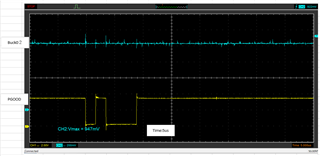
Thanks,
Hiroyuki
Hi Hiroyuki,
Okay I just wanted to make sure that this was the same issue
Can you tell me the full orderable part number that you are using? Are you sending any reads/writes to the registers? What is the process that you are doing to get to this point, and what state is the device in? Before this (or enabling the device) it may be helpful if you can read each of the registers and provide this to me.
Thanks,
Field
Hi Fleld,
I have attached two files.
"LP8756B2_0x111.txt "is the instructions for ordering the OTP.
It contains the detailed part number.
"Actual register.txt" is the register file read from the PMIC of the board we are considering.
We appreciate your cooperation.
Thanks,
Hiroyuki
REG 0x00 0x92 REG 0x01 0x11 REG 0x02 0xC6 REG 0x03 0x0E REG 0x04 0xC6 REG 0x05 0x3E REG 0x06 0xC6 REG 0x07 0x2E REG 0x08 0xC6 REG 0x09 0x0D REG 0x0A 0x61 REG 0x0B 0x00 REG 0x0C 0x2F REG 0x0D 0x00 REG 0x0E 0x2F REG 0x0F 0x00 REG 0x10 0xB1 REG 0x11 0x00 REG 0x12 0x23 REG 0x13 0x50 REG 0x14 0x41 REG 0x15 0x32 REG 0x16 0x14 REG 0x17 0x05 REG 0x18 0x00 REG 0x19 0x5E REG 0x1A 0x00 REG 0x1B 0x00 REG 0x1C 0x00 REG 0x1D 0x00 REG 0x1E 0x00 REG 0x1F 0xCC REG 0x20 0xCC REG 0x21 0x91 REG 0x22 0x01 REG 0x23 0x55 REG 0x24 0x55 REG 0x25 0x02 REG 0x26 0x00 REG 0x27 0x1A REG 0x28 0xC0 REG 0x29 0x12 REG 0x2A 0x00 REG 0x2B 0x01 REG 0x2C 0xD6 REG 0x2D 0x06 REG 0x2E 0x06 REG 0x2F 0x06
device: LP8756B2.dev name: LP87564WRNFRQ1 description: // LP8756/52/57 OTP Configuration File // Silicon version: B2 // Configuration: 1+1+1+1 // OTP ID: 0x111 // Customer: Melco // Generated: 12/09/2022 08:41:48 // // Beginning of Selectable OTP Configuration Bits // <LREGS> DEVICE_ID: 2 OTP_ID: 17 EN_BUCK0: 1 EN_PIN_CTRL0: 1 BUCK0_EN_PIN_SELECT: 0 BUCK0_FPWM: 1 BUCK0_FPWM_MP: 0 ILIM0: 1 SLEW_RATE0: 6 EN_BUCK1: 1 EN_PIN_CTRL1: 1 BUCK1_EN_PIN_SELECT: 0 BUCK1_FPWM: 1 ILIM1: 7 SLEW_RATE1: 6 EN_BUCK2: 1 EN_PIN_CTRL2: 1 BUCK2_EN_PIN_SELECT: 0 BUCK2_FPWM: 1 BUCK2_FPWM_MP: 0 ILIM2: 5 SLEW_RATE2: 6 EN_BUCK3: 1 EN_PIN_CTRL3: 1 BUCK3_EN_PIN_SELECT: 0 BUCK3_FPWM: 1 ILIM3: 1 SLEW_RATE3: 5 BUCK0_VSET: 97 BUCK1_VSET: 47 BUCK2_VSET: 47 BUCK3_VSET: 177 BUCK0_SHUTDOWN_DELAY: 2 BUCK0_STARTUP_DELAY: 3 BUCK1_SHUTDOWN_DELAY: 5 BUCK1_STARTUP_DELAY: 0 BUCK2_SHUTDOWN_DELAY: 4 BUCK2_STARTUP_DELAY: 1 BUCK3_SHUTDOWN_DELAY: 3 BUCK3_STARTUP_DELAY: 2 GPIO2_SHUTDOWN_DELAY: 1 GPIO2_STARTUP_DELAY: 4 GPIO3_SHUTDOWN_DELAY: 0 GPIO3_STARTUP_DELAY: 5 DOUBLE_DELAY: 0 CLKIN_PD: 1 EN4_PD: 0 EN3_PD: 1 TDIE_WARN_LEVEL: 1 EN2_PD: 1 EN1_PD: 1 GPIO_MASK: 1 SYNC_CLK_MASK: 1 TDIE_WARN_MASK: 0 I_LOAD_READY_MASK: 1 RESET_REG_MASK: 1 BUCK1_PG_MASK: 1 BUCK1_ILIM_MASK: 1 BUCK0_PG_MASK: 1 BUCK0_ILIM_MASK: 1 BUCK3_PG_MASK: 1 BUCK3_ILIM_MASK: 1 BUCK2_PG_MASK: 1 BUCK2_ILIM_MASK: 1 PG3_SEL: 3 PG2_SEL: 3 PG1_SEL: 3 PG0_SEL: 3 HALF_DELAY: 0 EN_PG0_NINT: 0 PGOOD_SET_DELAY: 0 EN_PGFLT_STAT: 0 PGOOD_WINDOW: 0 PGOOD_OD: 1 PGOOD_POL: 0 PLL_MODE: 0 EXT_CLK_FREQ: 1 EN_SPREAD_SPEC: 1 EN_PIN_CTRL_GPIO3: 1 EN_PIN_SELECT_GPIO3: 0 EN_PIN_CTRL_GPIO2: 1 EN_PIN_SELECT_GPIO2: 0 GPIO3_SEL: 1 GPIO2_SEL: 1 GPIO1_SEL: 0 GPIO3_OD: 0 GPIO2_OD: 0 GPIO1_OD: 0 GPIO3_DIR: 1 GPIO2_DIR: 1 GPIO1_DIR: 0 GPIO3_OUT: 1 GPIO2_OUT: 1 FOUR_ENABLE_MODE: 0 I2C_HS: 0 DIS_EN2_OTP_READ: 1 BUCK_FREQ_SEL: 0 I2C_ID_SEL: 0 EN_OVP: 1 MULTIPHASE_CONFIGURATION: 1 I2C_ID: 97 BUCK1_SC_MASK: 0 BUCK0_SC_MASK: 0 BUCK3_SC_MASK: 0 BUCK2_SC_MASK: 0 EN_FRAC_DIV: 0 EN_P_10M_BODY_DIODE: 1 EN_PROPORTIONAL_CHOKE_CONTROL: 1 EN_HIGH_FREQ_NEG_OCP: 0 EN_WAIT_CURRENTS_BALANCED: 1 EN_PREVENT_PHASE_ADD: 1 PROPORTIONAL_COEFF_BUCK: 4 COMPENSATING_RAMP_SLOPE: 5 ENABLE_CURRENT_BALANCING: 1 LONG_SINGLE_SHOT: 0 DIS_VREF_DAC_WAIT_P10M: 0 EN_INT_CHOKE_CTRL: 1 SET_NEG_I_COMP_OFFSET: 0 PFM_IPEAK: 19 PHASE_SHED_NEG_LIMIT: 0 IND_NEG_LIMIT: 1 EN_POS_NEG_OCP: 1 EN_SHED_PHASE_INT_CONTROL: 0 PFM_ENTRY_BUCK: 1 ADD_PHASES: 2 SHED_PHASES: 2 ADC_10M_WORD: 1 ADC_M0M_WORD: 2 ADC_P0M_WORD: 3 PLL_ICP_SEL: 1 EN_TWARN_DISABLES_BUCKS: 0 FORCE_SINK_BUCK3: 0 FORCE_SINK_BUCK2: 0 FORCE_SINK_BUCK1: 0 FORCE_SINK_BUCK0: 0 DIS_UVLO: 0 RESET_PREVENTS_STARTUP: 0 DIS_TSDH: 0 EN_BUCK_ENABLE_SHIFTER: 1 IDAC_LSB: 0 SLAVE_INTEGRATOR_STEP_DELAY: 1 POS_OCP_LEVEL_MSB: 0 PFM_IPEAK_RETENTION: 2 EN_RETENTION_MODE: 0 EN_10M_PROP_CONTROL: 0 EN_PG_COMPARATORS: 1
Hi Hiroyuki,
And can you tell me how you are arriving to this point? Is this on start up, shutdown, enabling the device, etc? Does it happen once, or every time during this aforementioned portion/process? Are you changing any of the registers, and if so at what point and what is the occurrence?
One thing that may stand out is register 0x29:

This would imply that the following bit below would be a 1 value for your board but in the OTP for this device, this bit looks like it is set to a 0, so I am a little confused on the above questions regarding the process or attempts that have been made so far. Register below:

Could you try again (with setting the masks accordingly), but set this bit to a value of 0 instead and inform me of the results? And let me know what you may have tested or changed previously in working with this?
Thanks,
Field
Hi Fleld-san,
The problem probably became more noticeable after updating the SoC firmware.
Since updated the firmware, the transient current consumption seems to have increased.
The SoC kernel starts and PGOOD periodically asserts low.
We will be testing register 0x29 soon, please wait a day or two.
Change the register value from 0x12 to 0x00?
Thanks,
Hiroyuki
Hi Hiroyuki,
So this is seen just during normal operation when a load is present?
Are you changing any of the registers, and if so at what point and what is the occurrence?
Assuming the register dump you provided is after (and if) you have written to the registers and the corresponding masks are present. Could you try a value of 0x02 to this register 0x29?
Thanks,
Field
Hi Fleld-san,
Yes, this occurs during normal operation under load.
Thanks,
Hiroyuki
Hi Fleld-san,
I have tested 0x29=0x02 and 0x28=0x00 and the PGOOD signal still asserts.
If there are any other registers to test, please advise.
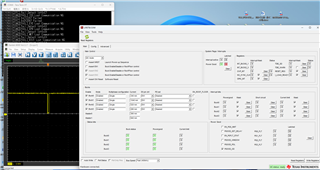
Thanks,
Hiroyuki
Hi Hiroyuki-san,
Field moved to a new position in TI. Let me look into this for you and I will reply by tomorrow (7/16).
Sorry for the delay,
Matt
Hi Hiroyuki-san,
Can you please capture the output rails along with the PGOOD signal in the oscilloscope capture? It would be good to see if there is any noise that might be causing PGOOD to trigger.
Best regards,
Matt
Hi Matt-san,
Please refer to the previous post.
I am capturing Buck2 and PGOOD signals,
This waveform looks noisy.
I think PGOOD is asserted because the overvoltage threshold has been exceeded.
However, even if I mask PG_SEL with 0h, this signal still appears,
so this doesn't make sense to me.
If you could explain the mechanism by which the signal appears even when PG_SEL is masked.
Best regards,
Hiroyuki
Hi Hiroyuki-san,
Can you let me know which register is being selected with this mask bit? I will dig into this more tomorrow - I think the mask bit might affect the INT pin, but I need to study this more to make sure.
Thanks,
Matt
Hi Mattsan,
I asked a TI Japan FAE about the register mask settings and did it carefully.
0x28=0x00
FAE said that with this setting, PDOOD is masked and no signal is output.
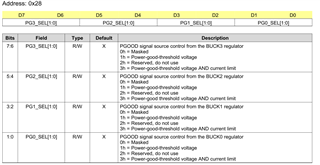
Best regards,
Hiroyuki
Hi Hiroyuki,
Has the PGOOD_FLT register been cleared also after writing to the register mask settings?
Regards,
Matt
Hi Matt-san,
The current OTP is 0x23=0x55, 0x24=0x55. This register setting does not latch the interrupt.
Therefore, there is no need to clear the GOOD_FLT register.

Best regards,
Hiroyuki
Hi Hiroyuki,
Let me ask some other engineers from the team to see if they can help understand what you are describing. I apologize for the delay and hope to reply on Monday with suggested next steps.
Best regards,
Matt
Hi HIroyuki-san,
I was looking at the value of the 0x16 register - I think I may suggest some changes to this register to see if it affects the behavior.
Hi Matt-san,
Are there any specific instructions for Register 0x16h?
The current OTP Register setting is 0x16=0x14.
In my opinion, 0x16 is a register for setting the GPIO delay step and has nothing to do with PGOOD.
Best regards,
Hiroyuki
Hello Hiroyuki-san,
Sorry, Matt is currently out of office until Monday 7/29.
He or I will try to get back to you by then.
Thank you for your patience.
Best Regards,
Sarah
Hi Sarah-san and Matt-san,
I hope the results of my analysis today will provide some clues.
I loaded our product's OTP into the LP87564Q1EVM, and the PGOOD status latched.
It seems that PGOOD is always asserted, as it latches immediately even after clearing it.
The load on the EVM is zero.
I would like you to carefully re-examine the OTO "Actual register.txt" that I sent to Fleld previously.
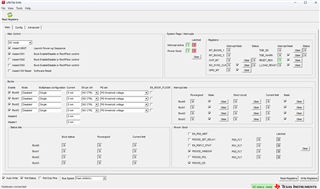
Best regards,
Hiroyuki
Hi Sarah-san and Matt-san,
Further experimental results:
Using the LP87564Q1EVM GUI, I changed the output voltage of OUT1 from 850mV to 855mV,
and the PGOOD was asserted.
Is this device really that sensitive?
waveform:
A change of 5mV cannot be measured at 200mV/div.
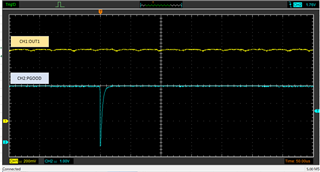
Best regards,
Hiroyuki
Hi Hiroyuki-san,
Thank you for providing your own experimentation results, this is certainly unexpected behavior.
I do not immediately see any issues with the register settings other than what has already been mentioned by Field and the FAE,
but let me see if I can replicate this setup on my end to further test and troubleshoot the issues.
I will get back to you with my findings.
Best regards,
Sarah
Hi Sarah-san and Matt-san,
Is the testing progressing?
Please let us know the status.
Best regards,
Hiroyuki
Hi Hiroyuki-san,
Apologies for the delay, it took longer than expected to receive the samples on hand. Testing will begin immediately and I will let you know what I find.
So sorry for the long wait.
Best regards,
Sarah
Hello Hiroyuki-san,
Apologies, we are still conducting testing on our end and are awaiting a soldering job, I will try to get back to you by tomorrow.
Again, I am sorry for the long delay.
Best,
Sarah
Hi Sarah-san,
Our company will be on summer vacation from Aug.9 to Aug.18.
We apologize for not being able to contact you during this period.
Best regards,
Hiroyuki
Hi Hiroyuki-san,
So far we did a simple check to see if the PG_SEL masking options were working with the EVM and we found that when BUCK2 PG2_SEL = 0, the PGOOD pin was not being pulled LOW by a BUCK2 PGOOD fault. This indicates that the mask setting is working.
This is what our GUI looks like before we run the test. We have PGOOD masked for all BUCKs:
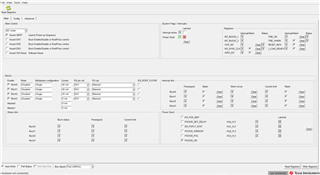
One thing I would like point out is that the "Power Good" system flag at the top will show 1'b for both the flag and the latched bit whenever one of the BUCKs is reporting PGOOD. This is normal and does not indicate a PGOOD issue. This flag bit is set to indicate that the output power of the PMIC is currently within regulation. The interrupt bit will show when a problem has occurred on a BUCK.
Even when PGOOD is masked, you will see 1'b for "Power Good" at the top of the GUI.
I still want to try and confirm that overvoltage specifically should not trigger PGOOD to go LOW when PGOOD is masked for BUCK2 but so far our testing shows that the mask bit should prevent PGOOD from going LOW.
Regards,
James
Hi Hiroyuki-san,
Can you share your schematic here as well?
What is the pull-up source for PGOOD?
Regards,
James
Hi James-san,
Thank you for testing so quickly.
Is there a waveform where PGOOD is not pulled low?
It is a short pulse of about 10us.
Please observe with the trigger set to normal or single.
This is an excerpt of the PGOOD pull-up circuit.
This is confidential information so I can't show you the whole thing.
PGOOD is pulled up to the CPU's VDD (+3.4V).
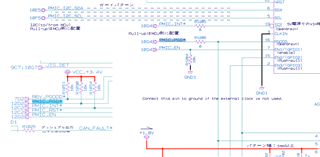
Best regards,
Hiroyuki
Hi James-san,
Let me confirm one more thing.
Please also observe the PGOOD signal when the GUI PG sel setting is "3h = Power-good-threshold voltage AND current limit".
Best regards,
Hiroyuki
Hi Hiroyuki-san,
Currently working on that scope capture.
Field mentioned register 0x29 earlier in this thread. Did you already test setting register 0x29 bit 5 = 1'b? This will set the PGOOD debounce delay to 1-11ms instead of 4-8us.
If your PGOOD is being pulled low due to periodic noise on BUCK2, the longer de-bounce time might be enough to ignore the noise spikes, so try changing that bit if you haven't already and let me know if that makes any difference.
If I can get a good image of PGOOD testing with and without masking bits I'll post it in a follow up reply.
Regards,
James
Hi Hiroyuki-san,
Here are some scope captures of the PGOOD behavior I'm seeing. It's difficult to induce the exact same noise behavior you experienced on your end so I had to settle with shorting the FB pathway to create an erratic BUCK2 output.
1) PGOOD is NOT masked, monitoring PG threshold only (overvoltage AND undervoltage)
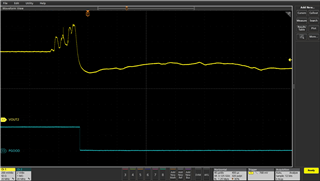
2) PGOOD is NOT masked, monitoring PG threshold AND current limit (overvoltage and undervoltage)
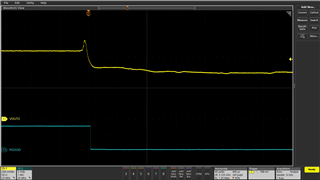
3) PGOOD is MASKED in all PG_SEL registers, PG is still set for overvoltage and undervoltage but expectation is that PGOOD will remain HIGH even during short event.

Regards,
James
Hi James-san,
Thank you for reporting the verification results.
I'm not sure about register 0x29, so I'll try again.
Oh and, is the register setting for the test board the OTP file that I sent to Fleld-san previously?
If there is no load on the test board, with our OTP setting the output voltage is 850mV and the phenomenon is unlikely to appear, so could you please test one of the OUTs at 500mV?
Then set the oscilloscope to single trigger and observe the test board for a while.
There is no rush to test these, you can do so after my testing of register 0x29 is complete.
Best regards,
Hiroyuki
Hi James-san,
I'm continuing testing today, but I'm having trouble reproducing PGOOD Low.
If you have time, please test the content of my previous post.
Best regards,
Hiroyuki
Hi Hiroyuki-san,
The experiments I ran above were done with the OTP you sent to Field.
If there is no load on the test board, with our OTP setting the output voltage is 850mV and the phenomenon is unlikely to appear, so could you please test one of the OUTs at 500mV?
Just to clarify, did you mean 500mA load should be applied to BUCK2 out and then PGOOD should be monitored to see if it is pulled LOW while PG_SEL is set to masked?
Regards,
James
Hi James-san,
I’m sorry for the late reply.
Set Buck1 output voltage to 500mV and monitor PGOOD.
Tests should be run without load.
In my past experience, I have come across PMICs whose output was unstable when there was no load.

Best regards,
Hiroyuki
Hi Hiroyuki-san,
Thanks for the clarification. We can double check this operation point and let you know what we find.
Regards,
James
Hi Hiroyuki-san,
We are still not seeing any PGOOD low signal even when running with Buck1 output voltage set to 500 mV as mentioned.
PGOOD signal remained high and was not triggered:
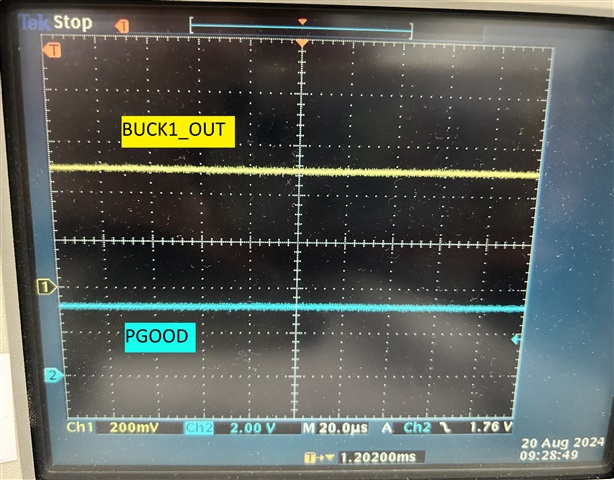
Best Regards,
Sarah
Hi Sarah-san,
Thank you for testing various things.
Since the problem does not occur at your company, we will check our test environment
and see if there is any source of noise.
I will close this forum for now and let you know if I find anything new.